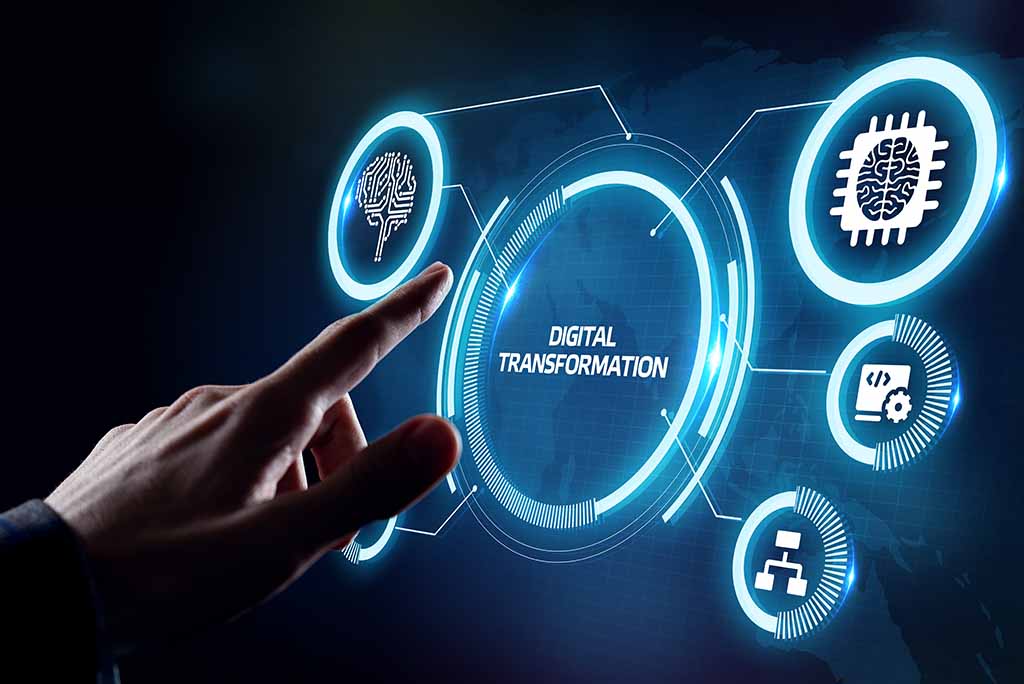Chapter 1: Defining Digital Transformation
What is Digital Transformation?
Digital transformation is a multifaceted concept, and understanding its various dimensions is crucial for any organization embarking on this journey. At its core, digital transformation represents a seismic shift in how businesses operate and engage with their stakeholders. It encompasses the integration of digital technology into all aspects of an organization’s activities, resulting in fundamental changes to its processes, culture, and overall business model.
Digital transformation extends beyond adopting specific technologies; it’s about fostering a holistic, technology-enabled environment that fosters innovation and agility. This transformation often involves embracing cloud computing, artificial intelligence, data analytics, the Internet of Things (IoT), and more. However, the technologies themselves are just tools; the real transformation occurs when they are harnessed strategically to drive business value.
The Evolution of Digital Transformation
To appreciate the significance of digital transformation today, it’s essential to recognize how far we’ve come. The digital transformation journey has evolved over several decades:
1. The Advent of Computers: Digital transformation’s roots can be traced back to the early adoption of computers in the mid-20th century. These machines automated tasks that were previously manual, streamlining business operations and laying the foundation for the digital future.
2. Internet Revolution: The proliferation of the internet in the 1990s marked a pivotal moment in digital transformation. It ushered in the era of online commerce, connectivity, and information sharing, revolutionizing how businesses interacted with customers and partners.
3. Rise of Mobile Technology: The emergence of smartphones and mobile apps further accelerated digital transformation. Companies had to adapt their strategies to cater to an increasingly mobile and connected customer base.
4. Cloud Computing: The advent of cloud computing transformed the way businesses store, access, and process data. Cloud services offered scalability, flexibility, and cost-efficiency, making it easier for organizations to experiment with new technologies.
5. Data-Driven Insights: In recent years, organizations have recognized the value of data as a strategic asset. Advanced data analytics and machine learning have enabled data-driven decision-making, allowing companies to personalize customer experiences and optimize operations.
6. Current Landscape: Today, we find ourselves in an era characterized by rapid technological advancements, including AI, blockchain, and edge computing. These innovations are driving new waves of digital transformation across industries.
Chapter 2: Why Digital Transformation Matters
The Business Imperative
In a highly competitive global marketplace, digital transformation is not just an option; it’s a necessity. Organizations that fail to embrace this shift risk falling behind, as they’ll struggle to meet evolving customer expectations, adapt to market changes, and fend off disruptive competitors.
Digital transformation isn’t solely about maintaining competitiveness; it’s about positioning an organization for future growth and relevance. By harnessing the full potential of technology, businesses can explore new revenue streams, expand into untapped markets, and unlock opportunities that were previously inconceivable.
Customer-Centricity
One of the most compelling reasons to embark on a digital transformation journey is the opportunity to become more customer-centric. With the advent of social media, online reviews, and instant communication channels, customers wield more influence than ever before. They expect seamless, personalized experiences, and they aren’t shy about expressing their opinions.
Digital transformation equips organizations with the tools and insights needed to cater to these evolving customer demands. By collecting and analyzing data, businesses can gain a deep understanding of their customers’ preferences, behaviors, and pain points. Armed with this knowledge, they can tailor products, services, and marketing efforts to create meaningful, long-lasting relationships with their customer base.
Operational Efficiency
Digital transformation also offers tangible benefits in terms of operational efficiency. By automating repetitive tasks, optimizing processes, and leveraging data-driven insights, organizations can streamline their operations, reduce costs, and enhance overall productivity.
Consider a manufacturing plant that integrates IoT sensors to monitor equipment health in real-time. Predictive maintenance algorithms can analyze this data and detect potential failures before they occur, minimizing downtime and reducing maintenance costs. Similarly, cloud-based collaboration tools can facilitate remote work and boost employee productivity, especially in today’s hybrid work environments.
Chapter 3: Key Elements of Digital Transformation
Technology Enablers
Technology is the backbone of digital transformation, and several key enablers play pivotal roles in driving this change:
1. Cloud Computing: Cloud services provide the scalability and flexibility needed to support digital transformation initiatives. They enable organizations to rapidly deploy and scale applications, reducing the need for extensive on-premises infrastructure.
2. Internet of Things (IoT): IoT devices collect and transmit valuable data from the physical world, enabling real-time monitoring, predictive maintenance, and enhanced customer experiences. In industries like manufacturing and healthcare, IoT has been a game-changer.
3. Artificial Intelligence (AI) and Machine Learning (ML): AI and ML empower organizations to automate tasks, analyze vast datasets, and extract actionable insights. These technologies drive personalization, recommendation engines, and predictive analytics.
4. Big Data Analytics: The ability to harness and analyze massive amounts of data is critical for making informed decisions. Big data technologies like Hadoop and Spark enable organizations to process, store, and analyze data at scale.
5. Blockchain: Beyond cryptocurrencies, blockchain technology offers secure and transparent record-keeping. It’s especially relevant in industries requiring immutable ledgers, such as finance and supply chain management.
6. Cybersecurity Solutions: As organizations become more digitally interconnected, cybersecurity becomes paramount. Robust security measures, including firewalls, encryption, and threat detection, are essential to safeguard sensitive data and maintain trust.
These technology enablers serve as building blocks for digital transformation strategies, and their selection depends on an organization’s unique goals and challenges.
Data as the Lifeblood
Data is often referred to as the lifeblood of digital transformation, and for good reason. It fuels the entire process, serving as the foundation for informed decision-making, personalization, and innovation. Here’s how data plays a pivotal role in digital transformation:
1. Data Collection: Organizations must establish efficient mechanisms for collecting data from various sources. This can include customer interactions, website analytics, IoT sensors, social media, and more.
2. Data Storage: Once collected, data needs a secure and scalable storage infrastructure. Cloud-based data warehouses and data lakes are popular solutions for managing diverse data types.
3. Data Analysis: Analyzing data is where the magic happens. Advanced analytics tools and algorithms extract valuable insights, patterns, and trends from data, empowering organizations to make data-driven decisions.
4. Data Security and Compliance: With great data comes great responsibility. Ensuring data security and compliance with regulations like GDPR or HIPAA is non-negotiable to maintain trust and avoid costly fines.
5. Data Integration: Data often resides in disparate systems. Integration platforms help consolidate data from various sources, providing a holistic view that aids decision-making.
Culture and People
While technology and data are essential components of digital transformation, the human element should not be underestimated. People, culture, and leadership play pivotal roles in the success of any transformation effort:
1. Leadership Buy-In: Transformation initiatives must have the support and commitment of leadership at all levels. Leaders set the tone, allocate resources, and communicate the vision.
2. Digital Culture: Fostering a digital culture is crucial for embracing change and innovation. This involves promoting a mindset of continuous learning, adaptability, and experimentation.
3. Talent and Skills: Organizations need a workforce equipped with digital skills. This often involves upskilling existing employees and hiring talent with the necessary expertise.
4. Collaboration: Cross-functional collaboration is key to breaking down silos and facilitating the flow of information and ideas. Encouraging collaboration can accelerate innovation and problem-solving.
5. Change Management: Change is inherently disruptive, and employees may resist it. Effective change management strategies are essential for addressing resistance and ensuring a smooth transition.
By recognizing the importance of culture and people in the digital transformation equation, organizations can create an environment where innovation and digital adoption thrive.
Chapter 4: The Digital Transformation Roadmap
Assessing Readiness
Before diving into a digital transformation initiative, organizations must gauge their readiness. Assessing readiness involves evaluating various facets of the organization, including:
1. Technology Infrastructure: Is the existing technology stack capable of supporting the planned digital initiatives, or are upgrades required?
2. Talent and Skills: Are there gaps in digital expertise among the workforce, and what measures are needed to bridge these gaps?
3. Data Capabilities: Is the organization equipped to collect, store, and analyze the necessary data for digital transformation efforts?
4. Culture and Leadership: Is there leadership alignment and commitment to fostering a digital culture, or are there cultural barriers that need addressing?
5. Customer Insights: What do we know about our customers, their preferences, and their expectations? Do we have the necessary mechanisms in place to gather and act on customer insights?
6. Competitive Landscape: How are competitors leveraging digital technologies, and what opportunities or threats does this present?
Once organizations have a clear understanding of their current state, they can identify gaps and areas requiring attention, forming the foundation for their digital transformation strategy.
Strategy and Planning
Crafting a robust digital transformation strategy is the next critical step. A well-defined strategy serves as the guiding light for the entire journey, ensuring that all initiatives align with the organization’s overarching goals. Here are some key elements of the strategy and planning phase:
1. Clear Objectives: Start by setting clear, measurable objectives. What does success look like, and how will you measure progress?
2. Stakeholder Alignment: Ensure that all stakeholders, from leadership to employees, understand and align with the transformation vision.
3. Prioritization: Not all digital initiatives need to happen simultaneously. Prioritize initiatives based on their potential impact and resource requirements.
4. Budgeting and Resource Allocation: Determine the budget needed for each initiative and allocate resources accordingly. Consider both capital and operational expenses.
5. Risk Assessment: Identify potential risks and mitigation strategies. Digital transformation initiatives often involve technical, operational, and even cultural risks.
6. Timeline: Create a realistic timeline for the transformation journey. Understand that digital transformation is an ongoing process, not a one-time project.
7. Technology Stack: Define the technology stack that will underpin your digital initiatives. Ensure that it aligns with your objectives and integrates seamlessly with existing systems.
8. Change Management: Develop a comprehensive change management plan that addresses employee concerns, facilitates training, and manages resistance.
Once the strategy is in place, it serves as the blueprint for the entire transformation effort. It provides a clear vision, ensuring that all stakeholders move in the same direction.
Execution and Implementation
The execution phase is where the rubber meets the road. This is where organizations roll out their digital initiatives, test new technologies, and implement process changes. Here are some considerations for effective execution:
1. Project Management: Adopt robust project management methodologies to ensure that initiatives stay on track, within scope, and on budget.
2. Agile Approach: In today’s dynamic environment, agility is paramount. Agile methodologies allow organizations to adapt to changing circumstances and customer feedback.
3. Technology Integration: Ensure that new technologies seamlessly integrate with existing systems. Avoid creating isolated technology silos.
4. Training and Upskilling: Invest in employee training and development to ensure that the workforce has the necessary skills to leverage new technologies effectively.
5. Data Governance: Implement data governance policies and procedures to maintain data quality, security, and compliance.
6. KPIs and Performance Metrics: Continuously monitor and assess the performance of digital initiatives against established KPIs. Use this data to refine strategies and make informed decisions.
7. Customer Feedback: Solicit and incorporate customer feedback into the development and refinement of digital products and services.
Effective execution demands strong leadership, effective communication, and a willingness to adapt as new information emerges. It’s a dynamic process that requires ongoing attention and iteration.
Monitoring and Iteration
Digital transformation is not a one-and-done endeavor; it’s an ongoing journey. Organizations must continuously monitor progress and iterate on their strategies to stay competitive and responsive to changing circumstances. Here are some aspects of effective monitoring and iteration:
1. Key Performance Indicators (KPIs): Regularly assess KPIs to gauge the impact of digital initiatives. These may include customer satisfaction metrics, revenue growth, cost savings, and more.
2. Feedback Loops: Establish feedback loops with both customers and employees. Customer feedback informs product/service improvements, while employee feedback helps refine internal processes.
3. Continuous Learning: Encourage a culture of continuous learning and improvement. Share insights and best practices across the organization.
4. Agility: Be prepared to pivot when necessary. External factors, market dynamics, and technological advancements may require adjustments to the transformation strategy.
5. Benchmarking: Compare your organization’s progress to industry peers and leaders. Benchmarking can help identify areas for improvement and innovation.
6. Scalability: Consider how digital initiatives can scale to accommodate growth. Scalability ensures that the organization can adapt to changing demands.
Digital transformation is not about reaching a final destination; it’s about building the capability to adapt and evolve continuously. Organizations that embrace this mindset are better equipped to thrive in a rapidly changing digital landscape.
Chapter 5: Digital Transformation Success Stories
Amazon: Revolutionizing Retail
Amazon, the e-commerce giant founded by Jeff Bezos, is a prime example of how digital transformation can disrupt traditional industries. What started as an online bookstore in 1994 has since evolved into one of the world’s largest and most influential companies.
Key Takeaways from Amazon’s Digital Transformation:
- Customer-Centricity: Amazon’s relentless focus on customer experience, convenience, and personalization has set new standards in e-commerce. Their recommendation engine and “one-click” ordering exemplify this commitment.
- Data-Driven Decision-Making: Amazon leverages data analytics to drive product recommendations, optimize pricing, and enhance supply chain management. Their use of data extends to customer reviews, which inform product improvements.
- Continuous Innovation: Amazon is known for its willingness to experiment and innovate. Initiatives like Amazon Web Services (AWS) and Prime membership have diversified its revenue streams.
- Supply Chain Optimization: The company’s investment in robotics and automation within its fulfillment centers has revolutionized supply chain logistics.
- Global Expansion: Amazon’s digital-first approach has allowed it to expand globally and enter new markets successfully.
Netflix: Redefining Entertainment
Netflix, founded in 1997 as a DVD-by-mail rental service, has fundamentally transformed the way people consume entertainment content. Its digital-first approach and data-driven recommendations have made it a household name.
Key Takeaways from Netflix’s Digital Transformation:
- Streaming Revolution: Netflix pioneered the transition from physical DVDs to online streaming. This digital shift gave viewers unprecedented control over what, when, and where they watch.
- Personalization: Netflix’s recommendation algorithm analyzes user behavior to suggest content tailored to individual preferences, enhancing user engagement and satisfaction.
- Content Production: Netflix’s investment in original content production has disrupted the traditional entertainment industry. Hit shows like “Stranger Things” and “The Crown” showcase the power of digital content creation.
- Global Reach: By leveraging the internet, Netflix expanded its services globally, reaching millions of subscribers worldwide.
- Data-Driven Insights: Netflix’s use of data extends beyond recommendations; it guides decisions regarding content acquisition, production, and licensing.
Tesla: Driving Automotive Innovation
Tesla, led by visionary entrepreneur Elon Musk, has reshaped the automotive industry by pioneering electric vehicles (EVs) and autonomous driving technology. Their digital-first approach extends from vehicle design to customer experience.
Key Takeaways from Tesla’s Digital Transformation:
- Electric Vehicle Leadership: Tesla’s Model S marked a significant shift in the perception of electric vehicles, demonstrating that they could be both stylish and practical.
- Over-the-Air Updates: Tesla’s ability to remotely update vehicle software is a testament to its digital-first mindset. These updates bring new features and improvements to customers’ cars without requiring a visit to a dealership.
- Autonomous Driving: Tesla’s investment in autonomous driving technology and its “Autopilot” feature showcases its commitment to innovation.
- Direct Sales Model: Tesla disrupted the traditional dealership model by selling vehicles directly to consumers, enhancing the buying experience.
- Supercharger Network: Tesla’s development of a global network of superchargers enables convenient, rapid charging for its EVs.
These success stories demonstrate the transformative power of digital technologies and the potential for organizations to redefine entire industries through innovation, data-driven decision-making, and customer-centricity.
Chapter 6: Overcoming Digital Transformation Challenges
Resistance to Change
Resistance to change is a common challenge in digital transformation efforts. Employees may fear job displacement or feel overwhelmed by new technologies. Addressing resistance requires a multi-faceted approach:
1. Communication: Open, transparent, and frequent communication is essential. Explain the rationale for change, the benefits it brings, and the support available.
2. Education and Training: Provide comprehensive training programs to equip employees with the skills and knowledge they need to adapt to new technologies.
3. Leadership Support: Ensure that leadership actively supports and champions the transformation effort. Leaders should set an example by embracing change themselves.
4. Inclusivity: Involve employees in the decision-making process where appropriate. Seek their input and feedback to make them feel valued and invested in the transformation.
5. Celebrate Successes: Acknowledge and celebrate milestones and successes along the transformation journey to boost morale and motivation.
Data Privacy and Security
The increasing reliance on data in digital transformation initiatives brings concerns about data privacy and security to the forefront. Organizations must take proactive steps to protect sensitive data:
1. Data Governance: Implement robust data governance policies and procedures to ensure data quality, security, and compliance.
2. Cybersecurity Measures: Invest in state-of-the-art cybersecurity measures, including firewalls, intrusion detection systems, and encryption technologies.
3. Compliance: Stay informed about data protection regulations, such as GDPR, HIPAA, and CCPA, and ensure strict compliance.
4. Employee Training: Train employees on data security best practices to minimize the risk of data breaches caused by human error.
5. Data Access Controls: Implement strict access controls to ensure that only authorized personnel can access sensitive data.
6. Data Encryption: Encrypt data both in transit and at rest to protect it from unauthorized access.
By prioritizing data privacy and security, organizations can mitigate risks and build trust with customers, partners, and regulators.
Budget and Resource Constraints
Digital transformation initiatives often require significant investments, and organizations may face budget constraints. To overcome this challenge:
1. Prioritize Initiatives: Focus on high-impact initiatives that align with strategic goals to make the most of limited resources.
2. Cost-Benefit Analysis: Conduct rigorous cost-benefit analyses to ensure that investments yield a return on investment (ROI).
3. Strategic Partnerships: Explore partnerships or collaborations with technology providers or industry peers to share costs and resources.
4. Phased Approach: Consider implementing digital initiatives incrementally, starting with a pilot project before scaling up.
5. Resource Allocation: Allocate resources based on priority and expected ROI, reallocating as needed as initiatives progress.
Successfully managing budget and resource constraints requires a careful balance between ambition and pragmatism.
Chapter 7: The Future of Digital Transformation
Emerging Technologies
The landscape of digital transformation continues to evolve, with several emerging technologies poised to shape the future:
1. Quantum Computing: Quantum computing has the potential to revolutionize data processing by solving complex problems at speeds unimaginable with classical computers. It could impact fields like cryptography, drug discovery, and optimization.
2. Augmented Reality (AR) and Virtual Reality (VR): AR and VR are opening new avenues for immersive experiences in various industries, from gaming and entertainment to training and healthcare.
3. 5G Connectivity: The widespread rollout of 5G networks promises ultra-fast, low-latency connectivity, enabling real-time data exchange and the proliferation of IoT devices.
4. Edge Computing: Edge computing pushes data processing closer to the source of data, reducing latency and enabling real-time decision-making. It’s essential for applications like autonomous vehicles and IoT.
5. Biotechnology and Genomics: Advances in biotechnology and genomics are transforming healthcare, with personalized medicine and gene editing offering innovative solutions to complex health challenges.
6. Sustainable Technologies: Sustainable technologies, such as renewable energy sources and green manufacturing practices, are becoming integral to digital transformation efforts as organizations prioritize environmental responsibility.
Understanding these emerging technologies is essential for organizations looking to stay at the forefront of digital innovation.
Ethical Considerations
As digital transformation accelerates, ethical concerns surrounding technology use have come to the forefront. Key ethical considerations include:
1. Data Privacy: Organizations must respect individuals’ rights to privacy and handle personal data responsibly.
2. AI Bias: AI systems can perpetuate biases present in training data. Ensuring fairness and equity in AI algorithms is a critical ethical consideration.
3. Automation and Job Displacement: Automation can lead to job displacement, raising questions about the societal impact and the responsibility of organizations to retrain or support affected workers.
4. Environmental Impact: As technology usage grows, its environmental impact, including carbon emissions, becomes a pressing ethical concern. Organizations should prioritize sustainable practices.
5. Responsible AI: Ensuring that AI technologies are used for ethical purposes, such as healthcare and education, while minimizing risks associated with misuse, is essential.
Navigating these ethical considerations requires a commitment to responsible innovation and a proactive approach to addressing potential risks.
Sustainability and Social Responsibility
Digital transformation offers opportunities to drive sustainability and social responsibility initiatives:
1. Environmental Sustainability: Organizations can leverage technology to reduce their carbon footprint, optimize energy consumption, and adopt sustainable supply chain practices.
2. Social Impact: Technology can be harnessed to address social challenges, such as access to education, healthcare, and economic opportunities for underserved populations.
3. Ethical Sourcing: Digital supply chain transparency enables organizations to ensure ethical sourcing of materials and products.
4. Philanthropy and Giving: Tech companies can contribute to social causes through philanthropic efforts and partnerships with non-profit organizations.
By aligning digital transformation initiatives with sustainability and social responsibility goals, organizations can create positive societal and environmental impact while pursuing business objectives.
Chapter 8: The Digital-First Future
In conclusion, digital transformation is not a singular event but an ongoing journey. It’s a journey that requires a strategic mindset, a commitment to innovation, and a customer-centric approach. Organizations that embrace digital transformation can unlock new opportunities, enhance competitiveness, and navigate the ever-evolving digital landscape with confidence.
As we wrap up this comprehensive exploration of digital transformation, it’s evident that the digital-first future is upon us. The organizations that thrive will be those that embrace change, leverage technology, and prioritize the needs and expectations of their customers. Digital transformation is not a choice; it’s a necessity for survival and success in the modern business world. So, are you ready to embark on this transformative journey?
Stay tuned for more insights, case studies, and practical tips on navigating the exciting world of digital transformation. The future is digital, and the possibilities are limitless.
Chapter 9: Industry-Specific Digital Transformation
Healthcare: A Prescription for Digital Transformation
Digital transformation has brought about significant changes in the healthcare industry, improving patient care, streamlining operations, and enabling new medical breakthroughs. Here’s how it’s reshaping healthcare:
Telemedicine Revolution:
Telemedicine has become a cornerstone of digital transformation in healthcare. It allows patients to consult with healthcare providers remotely, reducing the need for in-person visits. During the COVID-19 pandemic, telemedicine experienced unprecedented growth, highlighting its importance.
Electronic Health Records (EHRs):
EHRs have digitized patient records, making them easily accessible to healthcare professionals while ensuring data accuracy and security. This shift has enhanced patient care by enabling better coordination among healthcare providers.
Wearable Health Tech:
Wearable devices like fitness trackers and smartwatches provide real-time health data, empowering individuals to monitor their well-being actively. These devices also enable healthcare providers to gather patient data more comprehensively.
AI-Enhanced Diagnosis:
Artificial intelligence is revolutionizing medical diagnosis and treatment. AI algorithms can analyze medical images, such as X-rays and MRIs, with remarkable accuracy, aiding clinicians in making quicker and more precise diagnoses.
Drug Discovery:
In pharmaceuticals and drug discovery, AI and machine learning are accelerating the process of identifying potential drug candidates and predicting their efficacy. This has the potential to reduce development timelines and bring life-saving drugs to market faster.
Education: Transforming the Classroom
Digital transformation has reshaped the education sector, redefining the classroom experience and expanding access to learning. Here’s how it’s revolutionizing education:
Online Learning:
The proliferation of online courses and learning platforms has made education accessible to learners worldwide. This democratization of education allows individuals to upskill, reskill, and pursue degrees without geographical constraints.
Blended Learning:
Blended learning combines traditional classroom instruction with digital elements, such as online assignments and video lectures. This approach enhances engagement and flexibility, catering to diverse learning styles.
Virtual Reality (VR) and Augmented Reality (AR):
VR and AR technologies are creating immersive learning experiences. Students can explore historical sites, conduct virtual science experiments, or engage in medical simulations, enhancing their understanding of complex topics.
Personalized Learning:
AI-powered educational platforms analyze students’ performance and adapt learning materials to their individual needs. This customization ensures that students receive targeted support and resources.
Lifelong Learning:
Digital transformation has given rise to the concept of lifelong learning. Professionals can continuously update their skills, keeping pace with rapidly evolving industries.
Chapter 10: Case Studies in Digital Transformation
General Electric (GE): From Traditional Industry to Digital Powerhouse
GE, a renowned multinational conglomerate, embarked on a remarkable digital transformation journey. Originally known for manufacturing industrial equipment, GE shifted its focus toward becoming a digital industrial company.
Key Digital Transformation Initiatives at GE:
- Predix Platform: GE developed Predix, an industrial Internet of Things (IIoT) platform, to collect and analyze data from machines and equipment. This data-driven approach optimized operations, reduced downtime, and improved efficiency across industries.
- Digital Twin Technology: GE employed digital twin technology to create virtual replicas of physical assets, enabling real-time monitoring and predictive maintenance. This innovation significantly enhanced the reliability of industrial equipment.
- Service Transformation: GE transitioned from selling products to offering outcomes-based services. For example, instead of merely selling aircraft engines, they now provide “thrust as a service,” guaranteeing engine performance and reliability.
- Shift to Renewable Energy: GE recognized the growing importance of renewable energy sources and invested heavily in wind and solar power technologies, reinforcing its commitment to sustainability.
- Data-Driven Decision-Making: GE emphasized data-driven decision-making at all levels, harnessing data analytics to drive innovation and optimize processes.
GE’s digital transformation serves as a testament to how even established industrial giants can reinvent themselves through digital innovation.
The Walt Disney Company: Magic in the Digital Age
The Walt Disney Company, a pioneer in storytelling and entertainment, embraced digital transformation to redefine the way it engages with audiences.
Key Digital Transformation Initiatives at Disney:
- Disney+: Disney launched its own streaming service, Disney+, to compete in the rapidly evolving streaming market. Disney+ quickly gained millions of subscribers, thanks to its vast content library and beloved franchises like Star Wars and Marvel.
- MagicBand: Disney introduced the MagicBand, a wearable RFID device, to enhance the visitor experience at its theme parks. Visitors could use MagicBands for park entry, hotel access, and even to pay for meals and merchandise.
- Data-Driven Insights: Disney harnessed data analytics to gain insights into visitor preferences and behavior. These insights allowed for personalized experiences, from customized recommendations to character interactions in the parks.
- Direct-to-Consumer Approach: Disney shifted its focus from traditional distribution channels to a direct-to-consumer model, allowing it to connect with its audience more directly and on a global scale.
- Acquisitions: Disney strategically acquired companies like Pixar, Marvel, and Lucasfilm, expanding its content portfolio and strengthening its competitive position in the digital era.
Disney’s digital transformation illustrates how even iconic, legacy companies can leverage technology to stay relevant and meet evolving consumer expectations.
Chapter 11: The Role of Cybersecurity in Digital Transformation
The Growing Threat Landscape
As organizations embrace digital transformation, they become more reliant on digital assets and data. However, this increased digital presence also makes them more susceptible to cybersecurity threats. Here are some key cybersecurity considerations in the context of digital transformation:
Cyber Threats:
- Cyberattacks: The frequency and sophistication of cyberattacks, including ransomware, data breaches, and phishing, are on the rise. Organizations must remain vigilant in defending against these threats.
- IoT Vulnerabilities: The proliferation of IoT devices increases the attack surface. Unsecured IoT devices can serve as entry points for cybercriminals.
- Insider Threats: Malicious or negligent actions by employees or contractors can lead to data breaches. Effective access controls and employee training are essential to mitigate this risk.
- Supply Chain Attacks: Cyberattacks can target supply chain partners, compromising the security of the entire ecosystem. Organizations must assess and secure their supply chains.
Data Privacy:
- Regulatory Compliance: Data privacy regulations like GDPR and CCPA impose strict requirements on how organizations handle and protect personal data. Non-compliance can result in significant fines.
- Customer Trust: Data breaches erode customer trust. Protecting customer data is not only a legal obligation but also crucial for maintaining a positive reputation.
Cybersecurity Best Practices
To safeguard digital transformation initiatives, organizations should adopt robust cybersecurity practices:
Risk Assessment:
- Threat Assessment: Conduct a thorough assessment of cyber threats specific to your industry and organization. Identify potential vulnerabilities and their impact.
- Risk Mitigation: Develop a risk mitigation strategy that includes preventive measures, incident response plans, and disaster recovery procedures.
Security by Design:
- Secure Development: Implement security at every stage of software development. Incorporate security testing and code reviews to identify and remediate vulnerabilities.
- IoT Security: Ensure that IoT devices are secure by design, with encryption, authentication, and regular firmware updates.
Employee Training:
- Security Awareness: Educate employees about cybersecurity best practices, including how to recognize and report security threats like phishing emails.
- Access Control: Enforce strict access controls to limit access to sensitive data and systems based on job roles and responsibilities.
Cybersecurity Tools:
- Firewalls and Antivirus: Deploy firewalls and antivirus solutions to detect and block malicious activity.
- Encryption: Use encryption to protect sensitive data both in transit and at rest.
- Multi-Factor Authentication (MFA): Implement MFA to enhance authentication security.
Incident Response:
- Plan and Test: Develop an incident response plan that outlines steps to take in the event of a breach. Regularly test the plan through simulations.
- Forensics: Conduct digital forensics to understand the scope of a breach and identify vulnerabilities that need addressing.
Continuous Improvement:
- Threat Intelligence: Stay informed about the latest cyber threats and vulnerabilities through threat intelligence sources.
- Security Updates: Keep all software, hardware, and firmware up to date with security patches.
- Monitoring: Implement continuous monitoring to detect and respond to threats in real time.
Cybersecurity is not a one-time effort but an ongoing commitment to protecting digital assets and maintaining the trust of customers and partners.
Chapter 12: Digital Transformation and the Future Workforce
The Changing Workforce Landscape
Digital transformation is not only reshaping industries and business models but also redefining the workforce itself. Here are key trends and considerations in the context of the future workforce:
Automation and AI:
- Job Displacement: Automation and AI are automating routine tasks, potentially displacing certain job roles. Organizations must prepare for workforce transitions.
- Collaboration: Human-machine collaboration is becoming the norm. Employees will need to adapt to working alongside AI and automation tools.
Remote and Hybrid Work:
- Remote Work: The COVID-19 pandemic accelerated the adoption of remote work. Even post-pandemic, remote work is likely to remain prevalent, requiring organizations to optimize virtual collaboration and communication.
- Hybrid Work: Many organizations are adopting hybrid work models, allowing employees to work both remotely and in the office. This approach offers flexibility but also demands effective management and collaboration strategies.
Upskilling and Reskilling:
- Continuous Learning: Lifelong learning is essential as technology evolves. Organizations should invest in upskilling and reskilling programs to keep their workforce competitive.
- Digital Literacy: Digital literacy is no longer optional. Employees at all levels must be digitally literate to navigate technology-rich work environments.
Diversity and Inclusion:
- Virtual Inclusion: Organizations must ensure that virtual work environments are inclusive and equitable for all employees, including those from diverse backgrounds.
- Global Talent: Remote work opens opportunities to tap into global talent pools. Organizations can access a broader range of skills and perspectives.
Gig Economy:
- Flexible Work Arrangements: The gig economy offers flexible work arrangements, enabling organizations to access specialized skills on a project-by-project basis.
- Challenges: Managing gig workers and ensuring data security in this context pose unique challenges.
The Role of Leadership
Leaders play a crucial role in guiding their organizations and workforces through digital transformation:
- Adaptability: Leaders must be adaptable and open to change. They set the tone for a culture of continuous learning and innovation.
- Communication: Effective communication is key in times of change. Leaders should be transparent about digital transformation initiatives, their impact, and the organization’s vision.
- Empowerment: Empowering employees to embrace new technologies and take ownership of their learning and development is vital.
- Inclusivity: Leaders should champion diversity and inclusion, ensuring that all employees have equal opportunities to contribute and grow.
- Ethical Leadership: Ethical considerations, especially in the use of AI and data, should guide leadership decisions.
Digital transformation is not just about technology; it’s about empowering the workforce to thrive in the digital age.
Chapter 13: Conclusion and Outlook
As we conclude this comprehensive exploration of digital transformation, it’s evident that the journey toward a digital-first future is both transformative and ongoing. Organizations that embrace this evolution with a strategic mindset, commitment to innovation, and customer-centric approach are best positioned for success.
Digital transformation is not a choice; it’s a necessity for survival and success in the modern business landscape. The journey begins with understanding the core concepts, acknowledging its significance, and recognizing that the digital-first future is already here.
Stay tuned for more insights, case studies, and practical tips on navigating the exciting world of digital transformation. The future is digital, and the possibilities are limitless. Embrace the change, lead with vision, and empower your workforce to shape a digitally enriched future.
Related























































You must be logged in to post a comment Login